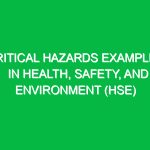Introduction
In an increasingly complex world, the management of risks related to health, safety, and the Environment (HSE) has become a critical responsibility for organizations across all sectors. Effective risk management not only protects employees and the community but also safeguards the environment, ensuring Sustainability for future generations. The term “examples of risk management” encompasses a wide range of strategies, practices, and methodologies aimed at identifying, assessing, and mitigating risks before they manifest into serious issues.
The essence of risk management in HSE is proactive rather than reactive. It involves understanding potential Hazards and implementing measures to minimize or eliminate risks. This article explores practical examples of risk management within the HSE domain, highlighting the significance of these strategies in promoting a safe working environment and a healthy ecosystem.
Key Aspects of Risk Management in HSE
Successful risk management in HSE requires a structured approach. Here are some key aspects:
1. Risk Identification
Risk identification is the foundational step in the risk management process. It involves recognizing potential Hazards that could harm employees, the public, or the environment. Common techniques for identifying risks include:
- Conducting Safety audits
- Utilizing hazard checklists
- Engaging employees in reporting potential risks
- Analyzing historical incident data
Real-world example: A construction company may conduct regular site inspections to identify risks such as falling objects or Electrical Hazards. By engaging workers in Safety meetings, they can gather insights on risks that might not be immediately apparent to management.
2. Risk Assessment
Once risks are identified, the next step is assessing their potential impact and likelihood. This step involves categorizing risks based on their severity and the probability of occurrence. Tools like risk matrices and qualitative assessments are commonly used.
For instance, a chemical manufacturing plant might assess the risks associated with chemical spills by considering the likelihood of occurrence and the potential environmental impact. This assessment allows them to prioritize risks effectively.
3. Risk Control Measures
Implementing risk Control Measures is crucial in mitigating identified risks. These measures can be categorized into several types:
- Elimination: Removing the hazard altogether, such as substituting hazardous materials with safer alternatives.
- Substitution: Replacing a risk with a less dangerous option, like using less toxic chemicals.
- Engineering controls: Designing equipment or processes to reduce exposure, such as installing ventilation systems.
- Administrative controls: Implementing policies, procedures, and Training to minimize risks.
- PPE (Personal Protective Equipment): Providing Safety Gear to workers to protect them from hazards.
A notable example is in the construction industry, where using harnesses and guardrails can significantly reduce the risk of falls.
4. Monitoring and Review
Risk management is not a one-time activity; it requires ongoing monitoring and review. Organizations should regularly evaluate the effectiveness of their risk management strategies and make necessary adjustments based on new information or changes in operations.
For instance, a manufacturing plant might analyze incident reports and near-misses to identify patterns that indicate areas needing improvement. Continuous feedback loops ensure that risk management practices evolve alongside the workplace environment.
Real-Life Examples of Risk Management in HSE
To illustrate the principles of risk management in HSE, let’s explore a few real-life examples from various industries:
1. Oil and Gas Industry
The oil and gas sector is fraught with risks, including explosions, spills, and environmental contamination. A prominent example of effective risk management is the implementation of a comprehensive Safety Management System (SMS). This system includes:
- Regular training programs for employees on emergency response and hazard recognition.
- Advanced technology for real-time monitoring of equipment and environmental conditions.
- Emergency response drills that simulate potential spill scenarios to prepare personnel for actual events.
These measures not only protect workers but also minimize the environmental impact of operations.
2. Healthcare Sector
In healthcare, patient safety is paramount. Risk management strategies include:
- Implementing electronic health records to reduce medication errors.
- Conducting root cause analyses for adverse events to identify preventive measures.
- Training staff on infection control protocols to prevent hospital-acquired infections.
By fostering a culture of safety, healthcare organizations can significantly reduce risks associated with patient care.
3. Construction Industry
The construction industry is known for its high rates of workplace accidents. A notable example of risk management is the use of Job Safety Analysis (JSA). This practice involves breaking down tasks into steps, identifying potential hazards, and implementing control measures before work begins.
For example, prior to starting a roofing project, a JSA might identify risks such as falls or falling objects. The team would then establish safety protocols, like using Fall Protection systems and ensuring that materials are secured.
Regulations and Standards Impacting Risk Management
Understanding Regulations and standards is vital for effective risk management. Various legal frameworks guide organizations in their HSE efforts. Some key regulations include:
1. Occupational Safety and Health Administration (OSHA)
In the United States, osha sets and enforces standards to ensure Workplace Safety. Organizations must comply with OSHA regulations, which require them to identify hazards, provide training, and maintain a safe work environment.
2. Environmental Protection Agency (EPA)
The EPA regulates environmental risks associated with industrial activities. Compliance with EPA standards helps organizations minimize their environmental footprint and protect public health.
3. International Organization for Standardization (ISO)
ISO standards, such as ISO 45001 for Occupational Health and safety management systems, provide frameworks for organizations to manage risks effectively. These standards encourage continuous improvement and stakeholder engagement.
Best Practices for Risk Management in HSE
Implementing Best Practices can enhance the effectiveness of risk management strategies. Here are some recommendations:
1. Foster a Safety Culture
Organizations should promote a culture where safety is prioritized. This can be achieved through regular training, open communication, and leadership commitment to Safe Practices. Employees should feel empowered to report hazards without fear of retaliation.
2. Engage Employees
Involving employees in risk management processes enhances buy-in and improves outcomes. Regular safety meetings and feedback sessions help gather insights from those directly engaged in operations.
3. Utilize Technology
Advancements in technology, such as drones for site inspections and software for data analysis, can significantly improve risk management efforts. Organizations should leverage these tools to enhance efficiency and effectiveness.
4. Conduct Regular Training
Continuous training ensures that employees are aware of potential risks and equipped to handle them. Organizations should implement ongoing training programs tailored to specific job functions and hazards.
Conclusion
In summary, effective risk management is essential for ensuring health, safety, and environmental sustainability across industries. Through proactive identification, assessment, and mitigation of risks, organizations can create safer workplaces and protect the environment. Real-life examples from various sectors illustrate the importance of tailored risk management strategies that comply with regulations and foster a culture of safety.
As we continue to navigate an ever-changing landscape of risks, it is crucial for organizations to remain vigilant and adaptable in their risk management practices. By doing so, they not only protect their workforce and the communities they serve but also contribute to a more sustainable future. Engaging in ongoing education and collaboration will further enhance the effectiveness of risk management efforts in the HSE domain.


